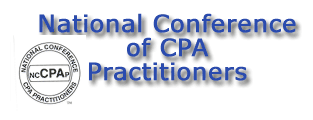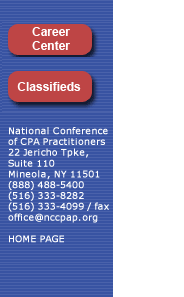

| |
|
|
|
|
|
|
|
|
|
|
|
|
|

September 2004
MEMBERS’
CORNER
BY STANLEY TEPPER, CPA, MBA
This column is devoted to articles which have appeared in the Estate Tax Newsletter from Stephen Silverberg & Lisa Hunter of Certilman, Balin Law Firm (516) 296-7000.
Conservation Easements –
QUESTION:
I have some undeveloped land, and I would like to keep it undeveloped. What requirements must I meet if I plan to use a conservation easement to protect the land and receive some income tax benefits?A conservation easement prevents certain types of development on the land, which it protects. The easement is either sold or donated by the landowner to a nonprofit or government agency. If granted in perpetuity, the conservation easement can provide the donor with charitable deductions for both income and estate taxes, and perhaps property taxes as well. The conservation easement must satisfy several requirements to qualify for a charitable deduction.
The donated interest must be a qualified real property interest, which can include the donor’s entire interest, a remainder interest, or a perpetual restriction on the use of the property.
The contribution must be made to a qualified organization.
The contribution must be made exclusively for conservation purposes, including the preservation of land areas for outdoor recreation by or education of the general public; the protection of a relatively natural habitat of fish, wildlife, or plants, or similar ecosystem; the preservation of open space (including farmland and forest land) for the benefit of the general public; or the preservation of an historically important land area or a certified historic structure.The conservation purposes must be protected in perpetuity, prohibiting any surface mining and any other use that would conflict with the purpose of the easement.
Social Security Benefits and In-Vitro Fertilization.
Children Conceived Posthumously Still Entitled to Social Security BenefitsDeveloping reproductive technology has outpaced the law, which currently does not address the legal issues created by posthumous conception. As a result, the courts have already begun to tackle some of these issues, rendering some interesting rulings. Most recently, the Ninth Circuit Court of Appeals has ruled that children conceived through in-vitro fertilization after the death of their biological father are entitled to Social Security child’s insurance benefits based on the deceased father’s earnings.
In 1994, Robert Netting was diagnosed with Cancer. At the time, he and his wife, Rhonda Gillett-Netting, were trying to have children. The couple decided to have Robert’s sperm frozen for Rhonda’s use if he died or was rendered sterile by chemotherapy. He died in February 1995. The in-vitro fertilization succeeded in December of that year, and Rhonda gave birth to Juliet and Piers Netting on August 6, 1996.
Rhonda applied on behalf of her children for Social Security child’s insurance benefits based on Robert’s earnings. The Social Security Administration (SSA) denied the claim, as did an Administrative Law Judge (ALJ). The ALJ held that, since dependants cannot be determined after the wage earner’s death under the Social Security Act, children conceived after the wage earner’s death could not be his dependants. A Federal district court upheld the ALJ’s ruling.
Rhonda took the matter to the Ninth Circuit, which determined that Juliet and Piers were Robert’s legitimate children under Arizona law, and noted that “all legitimate children automatically are considered to have been dependant on the insured individual. . . .”, The Court reversed the district court’s ruling and ordered that benefits be awarded.
Gillett-Netting v. Barnhart (9th Cir., No 03-15442,6666-9-04)Discounts Denied For Sloppy Family Limited Partnerships FLPs -
Discounts Denied for Sloppy FLPs
A recent Tax Court case illustrates the power of family limited partnerships (FLPs) for estate planning, as well as the importance of following the necessary formalities.
Mark and Michelle Senda had three children. The couple formed two FLPs in 1998 and 1999, in which Mark had a 10% general interest. Mark and Michelle shared an 89.8% limited interest, while Michelle held a 0.13% limited interest and each child held a 0.01% limited interest. The parents contributed shares of WorldCom stock to the FLPs in exchange for their interests, but these receivables were never placed in writing or paid.
On the day each FLP was formed, the parents gave each child substantial interests either directly or in trust. However, the certificates of ownership for these transfers were not prepared and signed until several years later. Also, while the FLP agreement provided that the general partner would prepare annual financial statements, none were ever prepared. Other formalities in that agreement were also ignored, such as annual partnership meetings. The FLPs kept no financial records, and the trusts that held the minor children’s interests wee not signed until 2000.
The couple’s gift tax returns for 1998, 1999, and 2000 reflected minority and marketability discounts ranging from 39% to 46%. The IRS denied them and assessed a deficiency of $487,567.
The Tax Court ruled that the 1998 and 1999 transfers of FLP interests were indirect gifts of stock and that the taxable value of the gifts should be based on the value of the WorldCom shares, not that of the FLP interests transferred to the children. Judge Cohen noted that Mark and Michelle, due to their failure to follow formalities, “presented no reliable evidence that they contributed the stock to the partnerships before they transferred partnership interests to the children.” However, the IRS agreed to allow a 46% combined discount for the gifts in 2000.
Senfda, et ux. V. Commissioner
(TC Memo, 2004-160,7-12-04)Trustee’s Option to Pay Estate Taxes Does not Make Insurance Proceeds Includible –
A husband and wife created an irrevocable life insurance trust (ILIT) with their daughter as trustee. This ILIT owned life insurance policies that would pay their proceeds directly to the trust upon the death of the second spouse to die. After the trust satisfies its debts and obligations, it is to distribute its proceeds outright to the couple’s children and grandchildren in specified proportions.
The trust instrument provides that the trustee is not required to pay any amounts to the estate of either the husband or wife in satisfaction of debts or liabilities of any kind. However, the trustee may, in its sole discretion, pay the estate tax, inheritance tax, or any other tax or expense due by reason of the husband’s or wife’s death, but shall be under no compulsion to do so.
The IRS ruled that this trust language, which gives the trustee the option to pay estate taxes without requiring such payment, would not result in the insurance proceeds being included in the estate of either the husband or the wife under §2042.
Source: PLR200147039 11-23-2001
